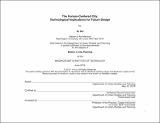| dc.contributor.advisor | Dennis Frenchman. | en_US |
| dc.contributor.author | Hu, Yu,M.C.P.Massachusetts Institute of Technology. | en_US |
| dc.contributor.other | Massachusetts Institute of Technology. Department of Urban Studies and Planning. | en_US |
| dc.date.accessioned | 2020-02-28T20:52:41Z | |
| dc.date.available | 2020-02-28T20:52:41Z | |
| dc.date.copyright | 2019 | en_US |
| dc.date.issued | 2019 | en_US |
| dc.identifier.uri | https://hdl.handle.net/1721.1/123957 | |
| dc.description | This electronic version was submitted by the student author. The certified thesis is available in the Institute Archives and Special Collections. | en_US |
| dc.description | Thesis: M.C.P., Massachusetts Institute of Technology, Department of Urban Studies and Planning, 2019 | en_US |
| dc.description | Cataloged from student-submitted PDF version of thesis. | en_US |
| dc.description | Includes bibliographical references (page 101). | en_US |
| dc.description.abstract | The first two Industrial Revolutions, together with modern economic and political systems, gave birth to modern cities, which became the prototype of cities as we live in today. Modern economy's pursuit of specialization and agglomeration lead to the separation of different urban functions. Meanwhile, efficient construction technique (characterized by steel and reinforced concrete) and modern transportation network strengthen such separation. However, this model of urban development prioritizes economic efficiencies, therefore it is fundamentally in conflict with human's biological needs. In other words, modern cities are not human-centered. Through a reflection on the rising new technologies of the fourth Industrial Revolution, such as Artificial Intelligence and Autonomous Vehicle, this thesis argues that if the next generation of cities can harness these technologies well, urban life can be more human-centered. One of the most significant realm in the fourth Industrial Revolution is the merging of Info-tech and Bio-tech, its breakthrough will overturn existing modes of living and production, creating new economic opportunities and subsequently, new spatial needs. Urban and architectural designers must keenly realize these trends and needs, actively embrace new technologies, and design spaces that truly prioritize the needs of human beings. The thesis proposes six future design principles that are more physical form related: 1) Small-scale; 2) Live/work Mix; 3) Permeable Public Space; 4) Interwoven Nature; 5) Attraction-driven; 6) Dispersion. These principles are formal manifestations of the spirits of the fourth Industrial Revolution. In the last chapter, they are applied on a chosen site near Central Square (Cambridge, MA) to create a productive live/work neighborhood. | en_US |
| dc.description.statementofresponsibility | by Yu HU. | en_US |
| dc.format.extent | 101 pages | en_US |
| dc.language.iso | eng | en_US |
| dc.publisher | Massachusetts Institute of Technology | en_US |
| dc.rights | MIT theses are protected by copyright. They may be viewed, downloaded, or printed from this source but further reproduction or distribution in any format is prohibited without written permission. | en_US |
| dc.rights.uri | http://dspace.mit.edu/handle/1721.1/7582 | en_US |
| dc.subject | Urban Studies and Planning. | en_US |
| dc.title | The human-centered city : technological implications for future design | en_US |
| dc.type | Thesis | en_US |
| dc.description.degree | M.C.P. | en_US |
| dc.contributor.department | Massachusetts Institute of Technology. Department of Urban Studies and Planning | en_US |
| dc.identifier.oclc | 1140446178 | en_US |
| dc.description.collection | M.C.P. Massachusetts Institute of Technology, Department of Urban Studies and Planning | en_US |
| dspace.imported | 2020-02-28T20:52:40Z | en_US |
| mit.thesis.degree | Master | en_US |
| mit.thesis.department | UrbStud | en_US |
